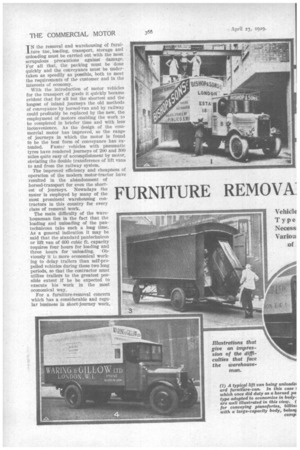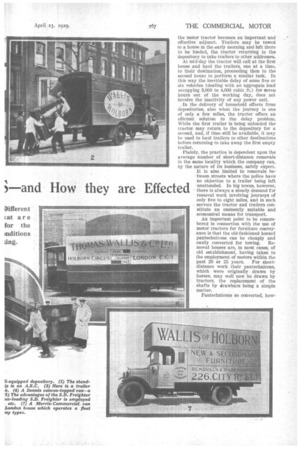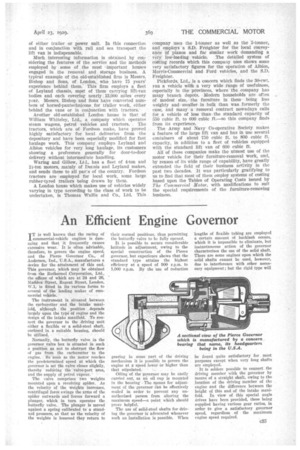T N the removal and warehousing of furniture tee, loading, transport,
Page 56

Page 57

Page 58

Page 59

If you've noticed an error in this article please click here to report it so we can fix it.
storage and unloading must be carried out with the most scrupulous precautions against damage. For all that, the packing must be done quickly and the conveyance must be undertaken as speedily as possible, both to meet the requirements of the customer and in the interests of economy.
With the introduction of motor vehicles for the transport of goods it quickly became evident that for all but the shortest and the longest of inland journeys the old methods of conveyance by horsed-van and by railway could profitably be replaced by the new, the employment of motors enabling the work to be completed in briefer time and with less inconvenience. As the design of the commercial motor has improved, so the range of journeys in which the motor is found to be the be form of conveyance has extended. Faster vehicles with pneumatic tyres have rendered journeys of 200 and 300 miles quite easy of accomplishment by motor, obviating the double transference of lift vans to and from the railway system.
The improved efficiency and cheapness of operation of the modern motor-tractor have resulted in the abandonment of horsed-transport for even the shortest of journeys. Nowadays the motor is employed by many of the most prominent warehousing eontractors in this country for every class of removal work.
The main difficulty of the warehouseman lies in the fact that the loading and unloading of the pantechnicons take such a long time. As a general indication it may be said that the standard pantechnicon or lift van of 600 cubic ft. capacity requires four hours for loading and three hours for unloading. Obviously it i more economical working to delay trailers than self-propelled vehicles during these two long periods, so that the contractor must utilize trailers to the greatest possible extent if he be expected to execute his work in the most economical way.
For a furniture-removal concern which has a considerable and reg,ular business in short-journey work, the motor tractor becomes an important and effective adjunct. Trailers may be towed to a house in the early morning and left there to be loaded, the tractor returning to the depository to take trailers to other addresses.
At mid-day the tractor will call at the first house and haul the trailers, one at a time, to their destination, proceeding then to the second house to perform a similar task. In this way the inevitable delay of some five or six vehicles (dealing with an aggregate load occupying 3,000 to 4,000 cubic ft.) for seven hours out of the working day, does not involve the inactivity of any power unit.
In the delivery of household effects from depositories, also when the journey is one of only a few miles, the tractor offers an efficient solution to the delay problem. While the first trailer is being unloaded the tractor may return to the depository for a second, and, if dine still be available, it may be used to haul trailers to other destinations before returning to take away the first empty trailer.
Plainly, the practice is dependent upon the average number of short-distance removals in the same locality which the company can, by the nature of its business, safely expect.
It is also limited to removals be tween streets where the police have no objection to a trailer being left
• Effected unattended. In big towns, however,
are
• Effected unattended. In big towns, however,
are
there is always a steady demand for removal work involving journeys of only five to eight miles, and in such service the tractor and trailers constitute an eminently suitable and economical means for transport.
An important point to be remembered in connection with the use of motor tractors for furniture conveyance is that the old-fashioned horsed pantechnicons can be cheaply and easily converted for towing. Removal houses are, in most cases, of old establishment, having taken to the employment of motors within the past 20 or 25 years. For shortdistance work their pantechnicons, which were originally drawn by horses, may well now be drawn by tractors, the replacement of the shafts by drawbars being a simple matter.
Pantechnicons so converted, how ever, having steel-tired wheels, cannot be drawn at speed, and their use is limited to distances of a few miles. To remove the old axles (the rear one being of the cranked variety for use with big wheels) and to substitute modern axles and wheels equipped with pneumatic tyres may be reckoned to cost about one-half of the outlay necessary to purchase an upto-date trailer. Even so, the procedure is often fovaid desirable, the resulting pneumatic-tyred vehicle being useful for every class of haulage, except that calling for the use of lift vans, of which more will be said later.
The point we wish to emphasize is that, in the inevitable change-over from horsed transport, the furniture removal business is not one In which old vehicles must be abandoned altogether; consequently, a heavy capital loss has not been necessary.
For the local conveyance of grand pianos and other very heavy articles which sometimes cannot be packed together with other furniture, the low-loading
vehicle is often indispensable. In these circumstances machines like the S.D. Freighter are extremely useful and perform excellent work.
The delay of t h e motorvan while it is being loaded and unloaded is a loss to be faced, but
c34 it does not represent so high a percentage of working time in the case of the vehicle engaged on longdistance removals as it would if a motorvan were employed for short-distance undertakings.
We have now to consider the removal of furniture between houses that are a long distance apart, so long, in fact, that the time saved by sending a lift van by rail, as against conveying it by motor, becomes a feature to be seriously (onsidered. Even when the distance is 200 miles or more it is frequently found that motorvans with trailers are preferable as a means for transport. For one thing, delays may occur in railway yards and sidings; for another, conveyance by road may be cheaper, especially if the railway station be at some distance from the house at either end of the journey ; a third, and very often a deciding factor, is that customers are inclined to prefer to have their household possessions carried directly from door to door in one vehicle.
The lift van plays an important part in removal work, especially in transporting to and from furniturestorage depots. By use of simple lifting gear at the depository the load may be removed from the motor chassis or trailer in a few minutes, an empty lift van being substituted and the vehicle quickly sent out upon its next duty. The lift van is unloaded or loaded at the depository without involving the delay of either trailer or power unit. In this connection and in conjunction with rail and sea transport the
lift van is indispensable. • — Much interesting information is obtained_ by considering the features of the service and the Methods employed by some of the most ,important houses engaged in the removal and storage business. A typical example of the old-established firm is Messrs. Bishop and Sons, of London, who have 75 years' experience behind them.' This firm employs a fleet of Leyland chassis, most of them-carrying lift-van bodies and each covering nearly',13,000. Miles every year. Messrs. Bishop and Sons litt`ye converted numbers of horsed-pantechnicons. for trailer work,behind the vans or in conjunction with tractors.
Aoother old-established London house is that of William Whiteley, Ltd., a company which operates steam wagons, petrol vehicles and tractors. The tractors, which are of Fordson make, have proved highly satisfactory for local deliveries from the depository and have been especially modified for fast haulage work. This company employs Leyland and Albion vehicles for very long haulage, its customers showing a preference generally for door-to-door delivery without intermediate handling.
Waring and Gillow, Ltd., has a fleet of 4-ton and 2i-ton motors, mainly of Dennis and Leyland makes, and sends these to all parts of the country. Fordson tractors are employed for local work, some large rubber-tyred trailers being drawn by them.
A London house which makes use of vehicles widely varying in type according to the class of work to be undertaken, is Thomas Wallis and Co., Ltd. This company uses the 1-tonner as well as the 5-tonner, and employs a S.D. Freighter for the local conveyance Of pianos and foe similar work demanding a
very low-loading vehicle. The detailed system of costing records which this company uses shows some very satisfactory figures for the operation of Albion, Morris-Commercial and Ford vehicles, and the S.D. Freighter.
Pickfords, Ltd., is a concern which finds the 30-cwt. van a vehicle with a very wide range of usefulness, especially in the provinces, where the company has many branch depots. Modern households are often of modest size, the furniture in them being less weighty and smaller in bulk than was formerly the case, and many a removal contract nowadays calls for a vehicle of less than the standard capacity of 550 cubic ft. to 600 cubic ft.—so this company finds from its experience.
The Army and Navy • Co-operative Society makes a feature of the large lift van and has in use several containers of about 750 cubic ft. to 800 cubic ft. capacity, in addition to a fleet of vehicles equipped with the standard lift van of 600 cubic ft.
All of these companies make the utmost use of the motor vehicle for their furniture-removal work, and, by reason of its wide range of capability, have greatly extended the field of their business activity in the past two decades. It was particularly gratifying to us to find that most of them employ systems of costing based upon the Tables of Operating Costs issued by The Commercial Motor, with modifications to suit the special requirements of the furniture-removing business.














































































































